
Consultant, choreographer, dancer and teacher, specializing in flamenco. Member off International Dance Council CID (UNESCO).
Cécile Apsâra’s work is rooted first in Paris in the world of culture in the 60s and 70s, then to Madrid and Seville in the flamenco. Fascinated by the theatrical aspect of this extraordinary art, she studied fully in Spain with the greatest artists. Accepted and integrated into several families of gypsy artists (Pedro Bacan, Angelita Vargas, Rafael Amador, PATA NEGRA), she delves into the life and customs of a country in order to understand the heart of this culture. She was a member of several dance companies including with Antonio Gades.
Flamenco being in the heart of her work, Cécile Apsâra has created many performances combining tradition and modernity.
Moreover, Cécile Apsara is very anxious to preserve the transmission of traditional repertoire flamenco, which remains the source of all creation and is part of a living heritage. She offers a conference / show for a discovery of the flamenco art through images, music and dance.
Based in Rennes since 2000, her experience as an educator has developed increasingly, she has trained musicians, amateur dancers and professionals thus creating a new and loyal public in the Brittany territory.
Both her knowledge of theatre, dramaturgical analysis and romanticism, and her theoretical and practical knowledge of flamenco has accumulated since the beginning of Cécile Apsâra’s career giving her a privileged role as counsellor and coach in many different ways:
• Vocational training: organization of Master classes with the great masters of dance and world music,
• Counselling programmers in flamenco,
• Assistance preparing roles for artists in opera, theatre, movies, magic shows or figure skating,
• cultural trips.
Cécile Apsâra’s flamenco : strength, endurance, a shared living experience.
Flamenco is a great way to express anger and frustration. It denounces all the injustices and represents for Cécile strength and resistance, a way of asserting their dignity.
The beginnings
Born in Paris into a family of musicians – her great-grandfather, pianist and composer Edouard Risler, her uncle Jean-Charles François, contemporary music composer and her mother Anne-Marie Francis, pianist, both playing with all Live music, Mauricio Kagel, Jean-Pierre Drouet … – very young Cécile Apsara begins to explore various art forms (music, dance, painting). She began ballet at the age of 7 at the Schola Cantorum and practiced African dance and aikido. In 1989, she obtained her Masters in Theatre Studies at the University of Paris III under the direction of Anne Ubersfeld.
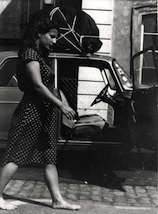
It starts in the theatre THESE PEOPLE WHO LIVE IN HOUSES OF GLASS alongside artists such as Mark Tompkins, with the Théâtre Autarcique in festivals off Nancy in 1979, Saarbrücken (Germany) and Polverrigi (Italy) in 1980. She worked in two Carolyn Carlson creations : 1988 in DARK as an assistant designer for Frederic Robert, and STEPPE in 1990 as an assistant costume designer.
<ligne|count=1> 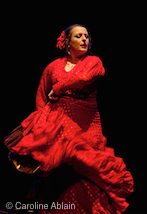
<ligne|count=4>
In 1986, Spain, Madrid, Seville but mostly she goes looking for the spirit and practice of the teaching of flamenco with great masters for over ten years: Angel Torres, Carmen Cortes, Ciro, Farruco, Juana Amaya, Manolo Marin, Angelita Vargas… Her meeting with Antonio Gades brought her the rigor and discipline of ballet direction and knowledge of traditional and contemporary repertoire of flamenco ballet. She danced an authentic flamenco all throughout her career, including CABARET FLAMENCO, or more recently 4X3 = FLAMENCO, traditional performances where she is surrounded by quality musicians such as Alberto Garcia , Mathias Berchadsky , Blas Deleria , Olayo Jimenez , Pedro Viscomi Martin …
Traditional flamenco
In 1986, Spain, Madrid, Seville but mostly she goes looking for the spirit and practice of the teaching of flamenco with great masters for over ten years: Angel Torres, Carmen Cortes, Ciro, Farruco, Juana Amaya, Manolo Marin, Angelita Vargas… Her meeting with Antonio Gades brought her the rigor and discipline of ballet direction and knowledge of traditional and contemporary repertoire of flamenco ballet. She danced an authentic flamenco all throughout her career, including CABARET FLAMENCO, or more recently 4×3=FLAMENCO, traditional performances where she is surrounded by quality musicians such as Alberto Garcia, Mathias Berchadsky, Blas Deleria, Olayo Jimenez, Pedro Viscomi Martin…
<ligne|count=2> 
<ligne|count=8> 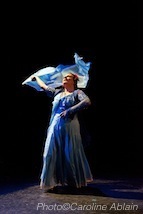
<ligne|count=3>
Contemporary creations
With flamenco at the heart of her work, the choreographer crosses theatre, dance, music, visual arts without ceasing to relate to the concerns and realities of today’s world.
SOLEA DE LA DAMA (founded in 1996 – Seville): an intimate adaptation of the Lady of the Camellias.
SECRET ARIA (1997 – Seville): a flamenco facing working women in contemporary society. This piece represents the young Andalusian creation for the first time Choreographic Encounters Madrid Albeniz Theatre in 1997 and was highly acclaimed at the Théâtre Mogador in Paris in 2000 as part of the Festival Estival danse.
PASSION With ARIA (2005 – Rennes) her research has focused on following the show SECRET ARIA, especially with the great master Manuel Soler with whom she created a rhythmic drawings show. Bringing Rennes, Paris and Andalusian artists PASSION ARIA was established in 2005 in St Avertin near Tours (37) South Pole in Chartres de Bretagne (35) and Square-Sevigne Cesson (35).
In 2006, she worked with actor Guillaume Doucet, guitarist Steven Fougères and percussionnist Jean-Marie Nivaigne using a Mérimée letter and later, the painter Nicolas de Staël. This meeting produced the creation of the shows HIGHWAY FLAMENCO and ENTRE TIERRA Y CIELO shown at the Museum of Fine Arts of Rennes and Théâtre de la Paillette in June 2006. The Festival Scriludes managed this.
<ligne|count=2>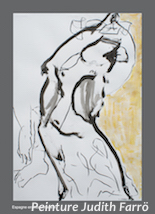
Between 2012 and 2015, Cécile Apsara worked on a solo contemporary flamenco, SOL that she experiments in various places: dance studios, coffees, museums, gardens, and in a festival of poetry.
Carried by the ancestors, the dancer asks social dancing to finally rise to itself, in the movement of inner strength.
<ligne|count=8>
Dance and theatre
In 2016, she created with Véronique Bouvet, a danced tale flamenco, OMA Cinderella’s ” too ” wonderful story which approaches themes such the modern slavery, the migration and the discrimination and thereby, the very present questions of pluralism, feminism and brotherhood.
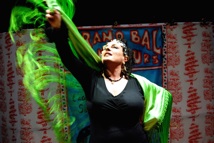
The opportunity for her to evoke its own route, its relation in the flamenco and its various expressions under a new, hard-hitting, committed and funny angle.
Outside look: Guillaume Doucet.
Help to the direction: Rozenn Tregoat.
The emancipation tells through the flamenco of Marine Combe Yeggmag.fr january 2017 > to read here
<ligne|count=1>
Advocacy
She creates various cultural activities in collaboration with cultural centres, middle schools, retirement homes, etc.
<ligne|count=1>
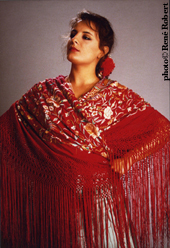
¿FLAMENCO? (2005 – Rennes) : Show conference for discovery of the flamenco art through images, music and dance. Available in English, French and Spanish.
Represented in Brittany, Ile de France, Luxembourg, Switzerland …
SUITE FLAMENCO (2008 – Rennes) : Play awareness offering a dance variation, a journey through different styles of flamenco from deep to more festive. A sensitive approach to many faces in solo, duo or trio …
Represented in various venues: festivals, community centres, retirement homes, neighbourhood parties, private parties, cabarets … since 2009 to date. (Creation Theatre Festival at the Theatre des Jacobins, Dinan (22). Festival Rendez-vous Conte, Quimper, 2011 Rennes stadium, 2011, etc.).
MADISON FLAMENCO (2012 – Noyal sur Vilaine) :
Participatory dance. Cécile Apsara dancer and choreographer invents and transmits a flamenco madison. Under CIRQUE OU PRESQUE the INTERVALLE Noyal-sur-Vilaine (35), after Charmatz contemporary madison and Olivier Férec burlesque madison.
TELL ME THE FREEDOM ! (2017 – Rennes): An action emancipator where the entertainment, the artistic and the politic rub shoulders.
Performances with amateur
LAS CARMEN (2008 – Rennes): a flamenco show with over a hundred students Apsara Flamenco workshops and a dozen professional artists. The Triangle, dance city in Rennes, 7 and 8 July 2008.
ANDA JALEO (2012 – Rennes) : a flamenco show around the civil war in Spain in 1936 with students APSÂRA Flamenco workshops. Triangle, dance city in Rennes, July 2012.
Artistic collaborations
Cécile Apsâra will share her artistic experience and her knowledge of the flamenco culture with different artists.
Based in Rennes, in 2001, she was responsible for the choreography of the show VAGABONDES ROOTS presented at Theatre of Vieux St Etienne in Rennes, show where she was both dancer and rider.
Since 2003, she has created and performed flamenco choreographies on brttany music with the group KENDIRVI.
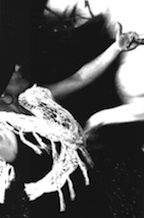
Cécile Apsâra is also facing the animation by creating choreography for the film LE CID‘s Emmanuelle Gorgiard music by Titi Robin. She has contributed to bringing her expertise to train facilitators puppets, record the sounds of the feet and hands and help design the postures and movements to make “flamenco”. This film was broadcast on ARTE in October 2006.
Between 2007 and 2010, Cécile Apsara has developed a work exchange with Cuban musician Beni Medina. Research Flamenco Rumba mixed with Cuban Son led to the creation of the show SALSA FLAMENCO shown in various places in Rennes, Brittany…
In 2010, she collaborated with Stéphanie d’Oustrac, opera singer, for the preparation of lead in CARMEN directed by Jean-François Sivadier at the Opera de Lille.
<ligne|count=4>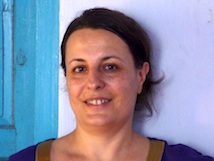
Transmission
Cécile Apsâra moves forward with passion and precision the expression of knowledge learned throughout her experience. Her pedagogy borrows from other disciplines breathing techniques, stretching and appropriate investments, awareness of the body and its movements. In addition, she has developed a musical ear and sense of rhythm by listening exercises and practice of percussion and singing. Finally, she uses her expertise in theatre to develop the interpretation.
One goal of the course is to implement acquired skills by the pleasure of dance and improvisation in festive gatherings.
<ligne|count=3>
What they say:
“Cécile Apsâra is part of this new generation of artists in Europe, while maintaining their cultural identity will tap into other cultures to forge a common language. Her artistic concerns led her to explore the world of flamenco and particularly that of the baile. Her theatrical and musical knowledge allows her to make the most of the long hours of observation of the world flamenco. Her broad vision of flamenco is reflected in her dance. It has to go beyond the study purely “academic” She sends our souls and thoughts statements. When she dances, there is a stream of emotion, something earthy that takes you directly to the bowels. She danced from one end to the other. her body and the energy it gives off is such that they only hand movements can bewitch you. In a word, while combining modernity and tradition, it has to reflect, translate that there are more natural and universal in flamenco dance. ”
Maria Gonzalez, Director of festival Mes de Danza – Seville
“From Brittany, another land of heritage, Cécile Apsâra known for her tenacity and commitment trace the path of a demanding flamenco, steeped in tradition and open to creativity. Her encounter with flamenco takes her, from her inception in Spain in the heart of Andalusia. By immersion, she will become smuggler, supported by her masters. Cécile Apsâra built, step by step, a rich and multidisciplinary artistic universe. She owes the peculiarity of her work to the crossing of the artistic experiences. Flamenco is theatre, she questions the physical theatre. Flamenco is movement, she paints. Flamenco is music, she questions the contemporary music. For Cécile Apsâra, flamenco is an expression which lives body and soul at the rhythm of the present time. ”
Christine BARBEDET, author

